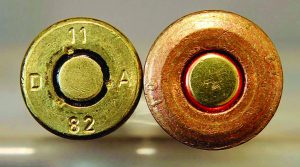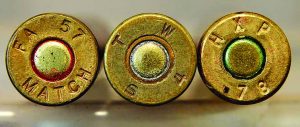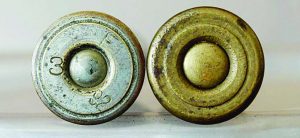By Art Merrill | Contributing Editor
Here’s a question handloaders end up fielding now and again: “Is it OK to reload brass that originally fired corrosive primers?”
Most recently, the question posed to me was in regards specifically to military surplus M2 Ball .30-06 brass. While a great many people apparently believe answers to political and social questions will fit nicely on a bumper sticker, we need a bit more space for a comprehensive understanding of the corrosive primer adventure if we’re to answer such questions knowledgably. The answer itself poses a question: “Corrosive to what?
Mercury & potassium
Primers may be corrosive in two ways. Mercuric primers, those containing fulminate of mercury, date back to 1822, when Alexander Forsyth patented the percussion cap, the corrosive igniting mixture of which was later carried over into metallic cartridge Boxer and Berdan primers. Mercuric primers pose a problem to handloaders in that once fired, the mercury amalgamates with the brass and causes it to become brittle. If such a case survives its trips through a sizing die, it may eventually fail upon firing. Because of the potential for case failures, firearms authorities have long advised against reloading cases that originally fired mercuric primers, even though reloading them was a practice of necessity for many in the early days of metallic cartridges.

Foreign military headstamps typically indicate year of manufacture, but discovering whether a specific cartridge has corrosive primers can take a bit of research. 7.5×55 Swiss (L) and 7.62×54 (R).
By 1900 the US military changed from mercuric primers to the Next Big Thing – potassium chlorate primers. Though US commercial manufacturers generally did likewise, at least one company, Western, apparently still loaded mercuric primers in match grade .30-06 and 45 ACP ammunition, and in H&H Magnum and Newton cartridges until at least 1941 and possibly up to the 1950s, before completely switching over to potassium chlorate and then noncorrosive primers.
The most commonly understood meaning of “corrosive primers” among shooters and handloaders is in reference to a firearm’s bore, rather than to the brass case. The potential for bore corrosion and accuracy reducing pitting and rifling erosion caused by chlorate primers is real, but it is readily mitigated by immediate and proper cleaning after a shooting session.
Upon firing, the potassium chlorate in the primer becomes potassium chloride, a salt, which deposits the length of the bore. The salt is hygroscopic – that is, it quickly attracts and holds moisture against the metal of the bore, corroding it; obviously it is a more serious problem in humid climates than arid environments. Since salt dissolves in water, cleaning the bore with water removes the chloride. Water was the “secret” ingredient in bore solvents ever since potassium chlorate primers hit the scene in the 1890s, but it only works if the shooter cleans soon after firing.
Anyone who has polished brass fittings on a ship knows that salt water will tarnish and dull brass. The problem may be more serious with brass cartridge cases, which are much thinner than a brass ship’s bell. Brass cartridge cases are an alloy of about 70 percent copper and 30 percent zinc. Exposure to saltwater weakens brass by “dezincification” where the zinc is lost (think of it as being dissolved out), leaving the copper porous (think of a colander) on a molecular level. Logically then, we might think it a bad idea to clean cases in a liquid media which, when mixed with the fired primer’s chloride, would create a saltwater mixture.
However, a generous quantity of liquid media should provide enough dilution to carry away the salts and work quickly enough to prevent dezincification. Still, if you don’t like the idea, you might clean in a dry media tumbler those fired cases that had been loaded with corrosive chlorate primers. But dry media doesn’t clean case interiors or primer pockets as well as liquid media, and so some chloride may remain behind inside the case and pocket, which then may deposit in the firearm’s bore upon firing even though we reload the case with a noncorrosive primer.
So, how about it? Do we reload cases that used chlorate primers? Theories aside, the reality is that I’ve never heard of any documented failures of cases previously fired with chlorate primers that had been cleaned by either dry or wet methods – that is, failures inarguably attributable to chlorate primers—so reloading such cases after cleaning is apparently a nonissue in that regard. Has reloading such cases and firing them with noncorrosive primers ever been proven to be the culprit in bore corrosion? Again, not that I’ve seen reliably documented. But it’s your bore, and it’s hard to fault anyone for erring on the side of caution. You can elect to not reload these cases without the need of a jury of scientists to support your decision.
Get the lead in
Again, especially in humid climates, it is important to clean immediately after a session of shooting with potassium chlorate primers. But this isn’t typically possible in a combat environment, so the military’s search for a non-hygroscopic replacement for potassium chlorate was on soon after they hit the streets.

These 1950s Frankford Arsenal M72 and Twin Cities Arsenal M2 Ball (left, center) 30-06 cartridges have noncorrosive primers. Foreign made Greek M2 Ball (right), manufactured in the 1960s, also has noncorrosive primers.
The lead styphnate primer, introduced in the 1920s in Germany, became the first commercially successful noncorrosive primer. Though commercial manufacturers and military forces quickly adopted it, the exigencies of WWII required continued use of corrosive chlorate primers, as well. Noncorrosive primers finally became standardized for the US military in 1949, and by 1950 all US military small arms ammo, including newly manufactured M2 Ball (and that was our original question, wasn’t it?) featured nonchlorate and non-mercuric primers, according to former NRA Technical Editor E. H. Harrison, whose experience working with the Army’s Ordnance department give his statement credibility. US military cases headstamped 1950 and later were loaded with noncorrosive primers; for those headstamped prior to 1950, it’s best to consider them as having corrosive primers. There is, as there always seems to be, an exception, in this case several lots of developmental test ammo loaded by Frankford Arsenal prior to 1950. These had zinc plated primers; the zinc intended to protect the primer cup from reacting with a component in the noncorrosive primer mixture. Since these few FA lots were small and remain unidentified, the post-1950 cautionary rule still stands.
The Ammo Encyclopedia (6th Edition, 2017, Michael Bussard) has information slightly differing from Harrison’s, stating Frankford Arsenal utilized chlorate primers “until the mid-1950s.” Another researcher has done us a service in publishing a paper that specifically identifies noncorrosive US manufactured military ammunition from WWII to 2001, including .30-06, 45 ACP and 7.62 NATO, by lot number and date; a free, downloadable PDF is online at: odcmp.org/1101/usgi.pdf.
Citing yet another exception to the 1950 rule, apparently no US military issue 30 Carbine ammo was ever loaded with corrosive primers. The reason is that testing showed small powder charges such as loaded in pistol cases like the 30 Carbine, combined with corrosive chlorate primers, created a bore corrosion problem more severe than in rifles with rifle ammunition. In trials, corrosion attacked the M1 Carbine’s polished gas piston so quickly that some were found rusted completely immobile overnight.
Got ID?
Corrosive primers in foreign milsurp cartridges is another matter, because different governments switched to noncorrosive primers at different times in different ammunition, and so it’s a subject way too convoluted to document specifics here. Generally speaking, however, because NATO formed in 1949 when the US adopted noncorrosive lead styphnate primers, NATO compliant ammunition manufactured since about 1960 – such as the milsurp M2 Ball from South Korea and HXP headstamped M2 Ball from Greece, both of which has been widely available in the US – is noncorrosive. Still, when in doubt about whether ammunition has corrosive primers, it’s wise to pour a cup of water or at least run some water-soaked patches through a bore after a shooting session.

Two black powder cartridges loaded near the turn of the last century. These will have mercuric primers and the one on the right, made of brass, should not be reloaded.
OK, it’s pretty much impossible to determine whether a primer is the mercuric, chlorate or lead styphnate type by simply using the MK1 MOD 0 Eyeball Check. However, milsurp cases typically (though not always) display a year of manufacture in the headstamp, which serves as a guide once you have the information already presented above. With NATO ammunition, the year of manufacture appears as two digits, such as “69” or “83” or “07.” NATO compliant ammo headstamps also include a cross-within-a-circle stamp that looks like the image of a crosshair in a rifle scope. The third bit of info on the NATO headstamp IDs the manufacturer.
Foreign non-NATO milsurp cartridges also may (though, again, not always) show a year of make. These usually feature Berdan primers and are not readily reloaded in the US; regarding bore cleaning, unless you are confident that they are indeed, noncorrosive, the water rule applies as a matter of caution.
Commercial ammo headstamps usually don’t display a year of manufacture, so we have little to go on here. However, it’s a safe bet that US manufactured cases since 1960 were not loaded with mercuric primers and so are safe for reloading.
So, if you can fit all that onto a bumper sticker readable to a driver behind you, you are an Awesome Concise Man.



